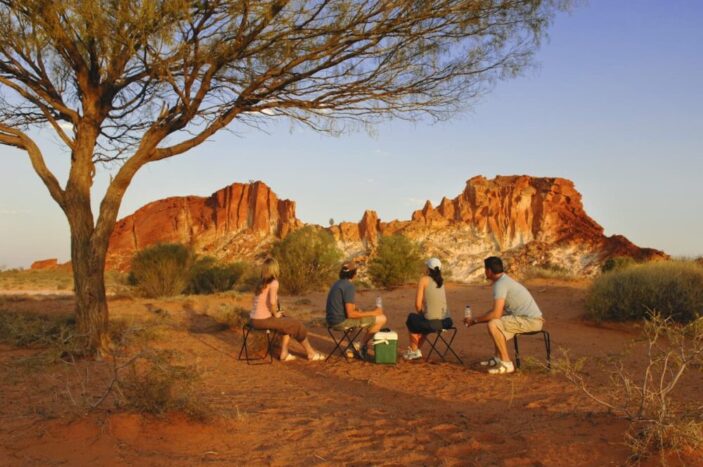
If Mother Nature had a favourite child, her name would be Alice.
Like two outstretched arms giving the dusty red town a warm (sometimes too warm) hug, the East and West MacDonnell Ranges wrap around Alice Springs/Mparntwe in a way that places the Red Centre amongst the world’s most impressive geographical wonders.
The local Arrernte people refer to giant caterpillars creating the region and forming these monolithic structures, which are predominantly made of red quartzite that shimmer as the scorching sun does its daily march.
The non-Dreamtime origin story for Alice Springs goes a little bit like this. Around 350 million years ago, an intraplate tectonic event caused a seismic shift in the earth’s crust, dramatically folding into itself and causing the land to rise – according to some, an unimaginable 5km into the air.
Over that incalculable period, folding, faulting, erosion and rain started to mold the region into what it is now, a pinch-yourself picture of vivid magenta, ochre and orange set against the sky’s deep blues and anchored by Central Australia’s definitive red dirt.
However the dusty Alice Springs region was formed all those millions of years ago, the natural place-making processes of erosion, chemical weathering, leaching and oxidation have made this a visually unforgettable sojourn into the heart and soul of Australia.
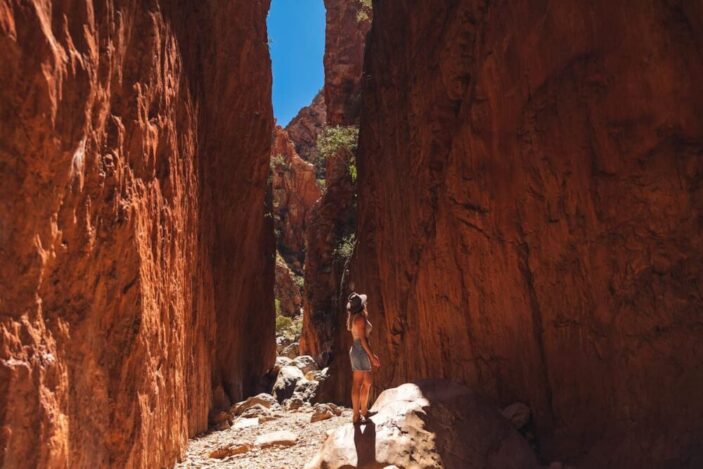
Why Alice Springs is so inspiring
The restorative, recalibrating bigness of nature this intense has long been a source of inspiration for the world’s greatest artists.
Take Georgia O’Keefe, for example.
One of the most important painters of the 20th century made her love of vast, dramatic landscapes an integral part of her identity. She was famously energised and embraced by the fascinating deserts of New Mexico, and she took her love of grandeur over to New York City, where the Concrete Jungle’s towering skyscrapers led to some of her most underappreciated pieces.
O’Keefe knew the value of being around things much, much bigger than yourself. That’s why forest bathing has become such a central component of “wellness”. Why people find hiking through the national parks so important. And why Alice Springs is famous for Aboriginal art. After all, traversing the region is like stepping inside an immersive landscape painting.
There are multiple art centres in Alice Springs: the world’s most important channels for Aboriginal art. The most famous painter from Alice, the late Albert Namatjira, built a reputation for photorealistic water colour paintings, incorporating Western techniques to produce some of most jaw-dropping landscape pieces you’re likely to ever see.
Others, including Kathleen Buzzacott and Jorna Newberry, have a unique way of looking at and interpreting nature. I daresay this perspective wouldn’t exist if they had grown up anywhere but the Northern Territory.
The transformative power of Alice Springs is best experienced via hiking its landscapes. Alice Springs itself is a typical outback town that’s more sleepy than spry. The energy is instead found outside of town, which is why it’s important to lean on local operators who have vast knowledge of the land.
Tip: Importantly, it’s always best to consider if your tour guide is able to credibly tell Dreamtime stories and properly contextualise the things you see. And the meaning they hold for the world’s oldest continuous culture.
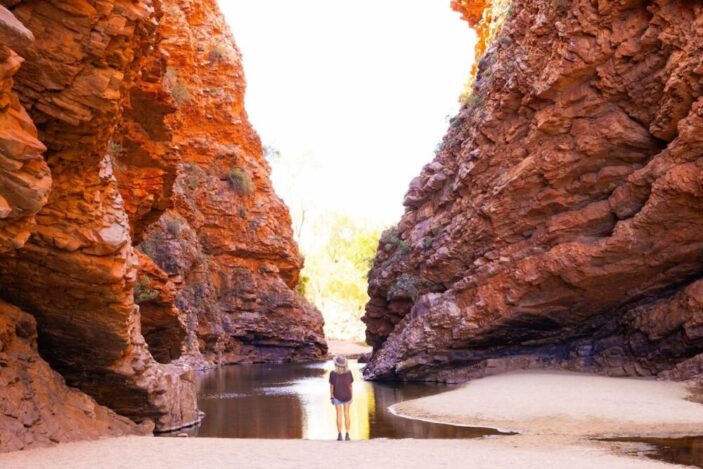
Things to do in Alice Springs: 5 best tours to take & what to see
Check in: Crowne Plaza Alice Springs is one of just a few recognisable brands clustered around the East Side of the Todd River, which only flows with water ever so often. The four-star IHG hotel has 205 guest rooms spread across several towers, an oversized pool with a generous hot tub, and large standard rooms with balconies. There’s also a sizeable gym, signature restaurant and an adjacent casino. Rates start from around $160 per night.
If it’s your first time in Alice, you’ll want to grab some bearings and know what you can do in town.
If art is front-and-centre for you, hop around the town’s many centres that deepen the ongoing story of the Northern Territory’s world-renowned creative community.
Bindi Enterprises is one of the most important, exclusively supporting and advocating for artists who live with disabilities and displayed their work in a small gallery space.
Much bigger and more high-profile is the impressive Araluen Arts Centre, which has its own theatre, is getting the Archibald for the first time later this year, and features one of the best collections of Aboriginal artwork I’ve seen anywhere in Australia. You’ll spot several of Albert Namatjira’s meditative works here.
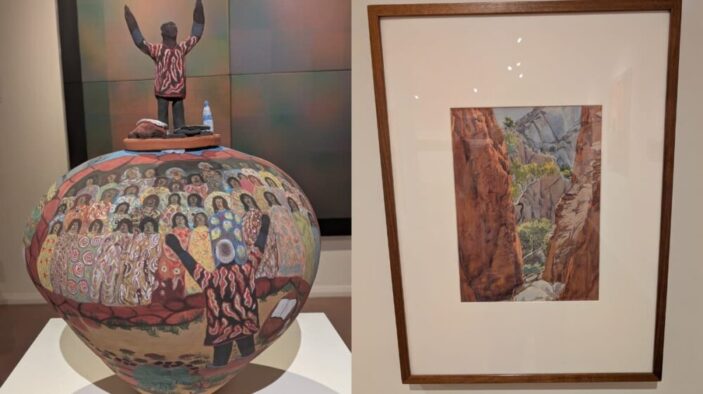
One of the town’s most famous restaurants, Hanuman, is a hit-or-miss collection of South-East Asian with some Indian dishes. Your palate is better taken care of in the earlier hours of the day, with the hip Page 27 the town’s best cafe and The Bakery a winner when you want a ‘roo pie and a coffee. Food isn’t bad isn’t Alice Springs, but it pales in comparison to the market-loving diversity up in Darwin.
Tip: Note that Alice Springs doesn’t have the most consistent trading hours and you’ll find some shops shut in the early afternoon. Phone ahead to make sure things are open if you’re sitting at around 2pm.
One of the more unique tours to do in Alice Springs doesn’t feature much movement, or driving, at all. You head on out to patch of land with Earth Sanctuary – a 15-minute ride from town – and stare at a frictionless sky papered in twinkling stars, enough for guides to point out prominent constellations. A bit of modern tech is used to deepen the tour as well, taking you in a dome with a high-powered telescope so you can count the pockmarks that cover the moon.
Tip: The photo above was taken using a Google Pixel 9 Pro gently pressed up against the telescope. It’s hard to keep the camera still enough to get the shot, so you’re better off asking your guide to capture a shot for you, using your phone.
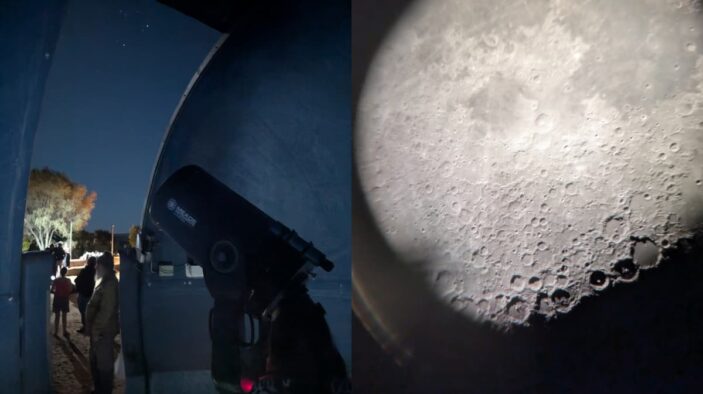
Earth Sanctuary is only of three places in Australia that offer such a rich and fascinating exploration of the night sky, making any Alice Springs trip much more than just about the earthly landscapes. There’s plenty of room for the tourism product to expand too, like bringing in an Aboriginal guide versed in the important navigational value of these celestial features.
The quintessential thing to do in Alice Springs is get up close to the sandstone walls of the MacDonnell Ranges. Flexible tour operator Alice Springs Expeditions is your best bet here, with the affable John Stafford and his wife offering a number of expeditions, whether you want to explore East or West.
The West MacDonell National Park, Tjoritja, is most famous for the Simpsons Gap, a toothy break in the otherwise continuous sandstone walls, allowing natural light to spill onto the water. This is when having a local Aboriginal guide is highly recommended as you’ll get to hear more about the navigation and symbolism of the land.
For that, 100% Finke River, Culture & Adventure Tours is the way go with a detailed picture of the land and what it takes to survive the often harsh conditions of the desert. Local figure and Western Arrarnta man Benjamin (Benji) Kenny
Various plants and wildlife thrive at Simpsons Gap so you’ll likely spot a few black-footed rock-wallabies jumping around the rocks.

The fourth necessary tour is run by Sandrifter Safaris, another generalist around the region perhaps best known for their Rainbow Valley Sunset Tour. The 4×4 track into Rainbow Valley is a visual delight in itself, trailing a gravelly road with chocolatey red dirt and hundreds of ghostly desert oak trees, with their leaves flowing downwards towards the dirt. Again, Alice’s aesthetics are unmatched.
The free-standing bluffs and cliffs of Rainbow Valley form part of the James Range, presenting another Jurassic-looking monolith that best represents Mother Nature’s fondness for Alice. She’s painted it perfectly, using rain to extract the irons which transmute the colour so the rocks are a patchwork of different hues.
Sunset is time to go as the scorcher acts as a mirror when it’s dipping behind the mountain, shimmering the reds and oranges so you get a cinematic sense of just how impressive Central Australia’s outback can be. Getting to tailgate with a sunset charcuterie board and locally crafted Ginger Beer once darkness hits is an added bonus.
In many ways, Rainbow Valley reminds me of my time out in Nevada’s majestic Red Rock Canyon, which is framed by a similar suite of multi-coloured rocks that have had their iron sucked out across centuries.
Other must-visits around Alice Springs include the rocky Standley Chasm, similar to Simpsons Gap with its photogenic rust-red walls. For something different, get your guide to take you over to Ellery Creek Big Hole. There are a few watering holes around Alice Springs (don’t worry, it’s too far south for crocs – but do your due diligence and watch for appropriate signage if concerned) and this is the most famous of them, a successful escape from the heat with perfect temperatures and that almost religious-like visual of light hitting the water as it manages to squeeze between the cliffs.
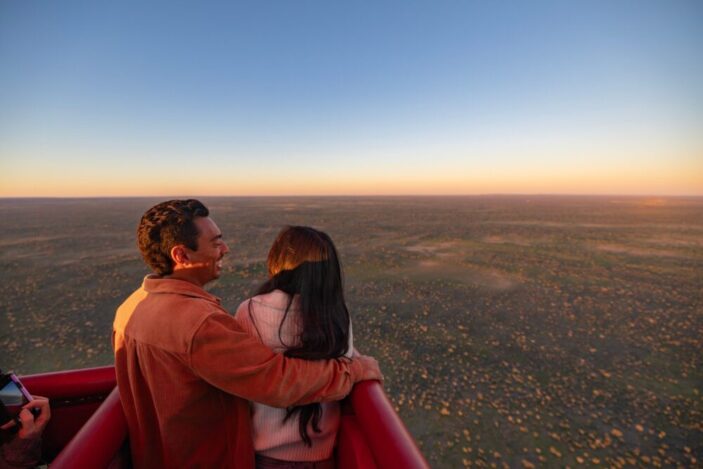
The fifth tour I would suggest taking when you visit Alice Springs doesn’t involved driving or hiking. It involves waking bright and early, hoping and praying the weather behaves (this isn’t Canberra or the Barossa – it’s more stable) and taking flight in a hot air balloon.
While most people tend to think of the east coast when it comes hot air ballooning in Australia, hot air ballooning in Alice Springs takes a hard left turn into surrealism. Northern Territory sunrises are legendary and unobstructed, so you’ve got that, but you’re also floating over the rugged desert landscape and watching the land brighten as the sun starts to spread its wings. It’s like flying over an Aboriginal landscape painting, with all the spinifex dotted around to bring patches of grey and green to the multi-hued red earth. I don’t need to write it again, but I will; Alice Springs is visually unforgettable.
Tip: It was my first hot air ballooning experience, so I didn’t know that the basket actually lands softly on its side once dipping back down to earth. You’ll be lying horizontally trying to get out of the basket. That’s no problem, but when you’re getting out – and you’re on the bottom half closest to the ground – be careful where you put your hands to help you slide out. Alice Springs has a lot of spiky plants and bindies that can sting (at worst, poison). You’re unlikely to find the latter around the landing zone but take it from someone who blindly put their hands on a sea of spikes – watch where you’re putting your hands.
These natural experiences are not only deeply spiritual for Australia’s indigenous population, the source of great strength, inspiration and healing, but they are also greatly impactful for visitors. Again, being around the bigness of nature has a soulful effect that’s both abstract and deeply personal.
I think a lot of people need Alice in their lives right now.
How do I get to Alice Springs?
Alice Springs Airport is tiny and easy to navigate. Qantas has the most routes into town, with the full weekly flight volume below:
- Adelaide – 8 return flights per week
- Brisbane – 3 return flights per week
- Darwin – 12 return flights per week
- Melbourne – 4 return flights per week
- Sydney – 6 return flights per week
The writer flew to Adelaide on Qantas as a guest of NT Tourism and their current Love Letters to Alice campaign.
Feature image: Tourism NT/Steve Strike.
